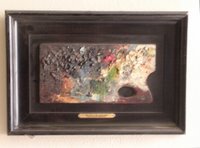Rudolph Weisenborn
 Portrait of Rudolph Weisenborn (1881-1974)
Portrait of Rudolph Weisenborn (1881-1974)by Stanislaus Szukalski, 1919
In some ways,
Rudolph Weisenborn was the ideal
member of an art club --
because he was so committed to the cause of art,
and he wasn't just looking for personal benefit.
But in other ways,
he was an impossible member,
because he was such an extremist.
So he made a good companion,
(and possibly the only companion)
for
Stanislav Szukalski
the great Chicago Wunderkind, autodidact, and seer.
 His great dream was to create
His great dream was to createa "Gallery of Living Artists"
as depicted in his above drawing,
where he depicted an eager artist
approaching the temple of self expression.
And that's pretty much was Rudolph's ideology:
self expression,
as realized in the the three organizations he helped to found:
*the No-jury Society
*The Cor-Ardens (the ardent hearts)
*The Neo-Arlimusic (art-literature-music)
He was indefatigable in throwing costume balls
to raise money for his dream,
 including selling raffle tickets for his
including selling raffle tickets for hisabove portrait of Clarence Darrow
Finally, in February 1928
it all came together with a special exhibit
for the benefit of the renowned art critic
Julius Meier-Graefe
With former P&C member Carl Hoeckner
acting as translator,
Meier-Graefe was introduced to the exhibit,
but was reported to have
"failed to find anything significant"
After that,
Rudolph seems to have limited his interest in art
to just painting and teaching.
 1926
1926According to the Susan Weininger essay in
"The Old Guard and Avant-garde",
"Weisenborn, who was orphaned at nine, lived in various midwestern locations before settling in Colorado, where he eventually enrolled in the Student's School of Art and paid his tuition with money earned working as a janitor. He learned to paint in an academic manner which is evidenced by his self portrait of 1903; we know that he was very proud that his work suggested Rembrandt's style. He arrived in Chicago in 1913 wearing six shooters and a Stetson hat"
Weininger continued with a critical evaluation that ran:
"It is in the work of Weisenborn, an artist who spent the majority of his adult life in Chicago, that we see the emergence of a true Chicago modernism. Although an unfortunate fire in his studio in 1922 destroyed much of his early work --- his portraits --manifest the variant on cubism that evolved with his work. While lacking the intellectual rigor of the European style, they have a forceful, dynamic vigor that conveys a tense and unyielding energy resonating with the life of the modern city"
I like the description of "tense unyielding energy",
(which is not especially appealing to me)
but wonder just how "intellectual rigor"
can be proven present or absent
except in the writing of a critic.
 1929
1929 1930
1930 1930
1930 1935
1935 1935
1935 1937
1937 1939
1939 1953
1953




0 Comments:
Post a Comment
<< Home